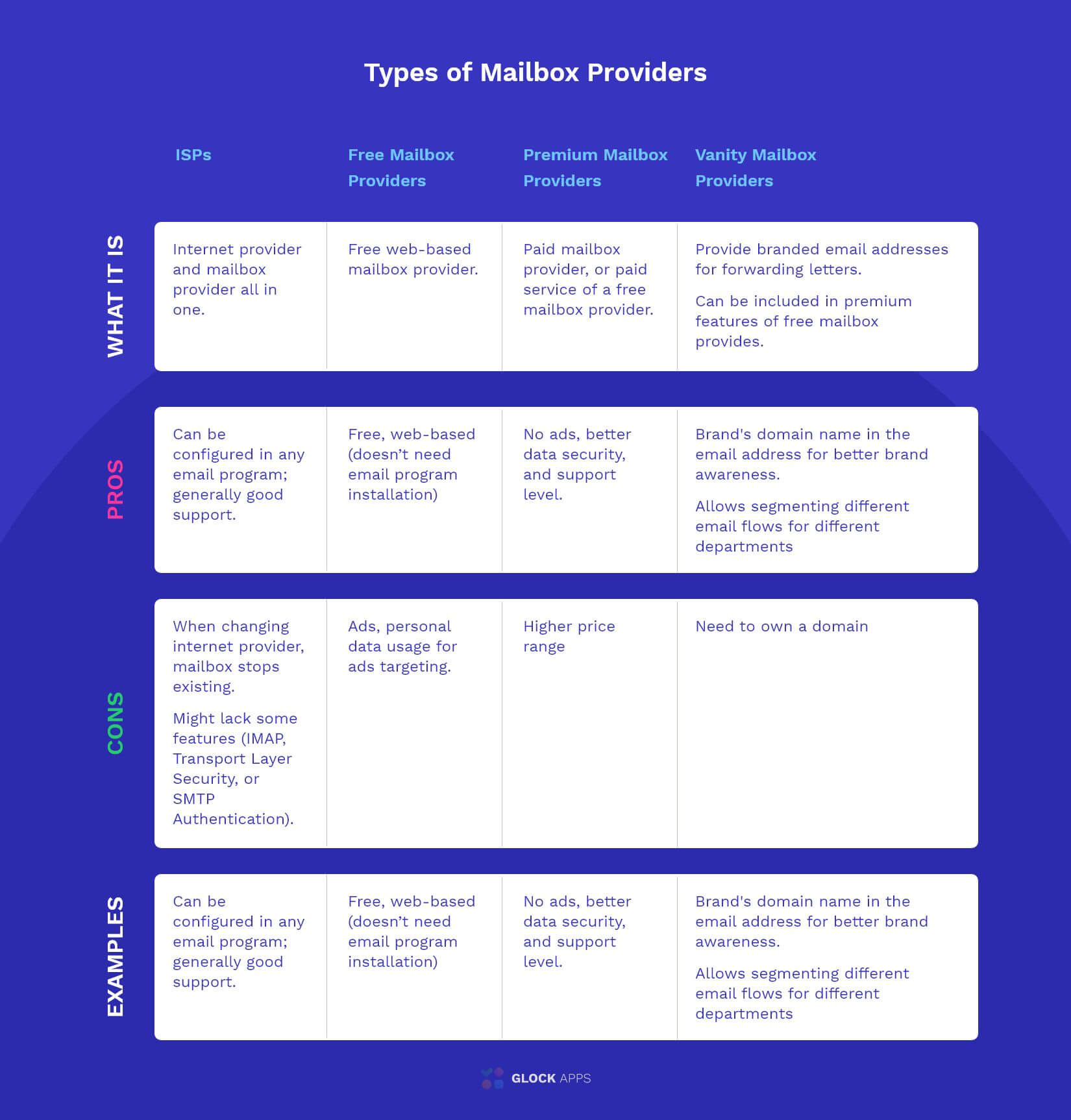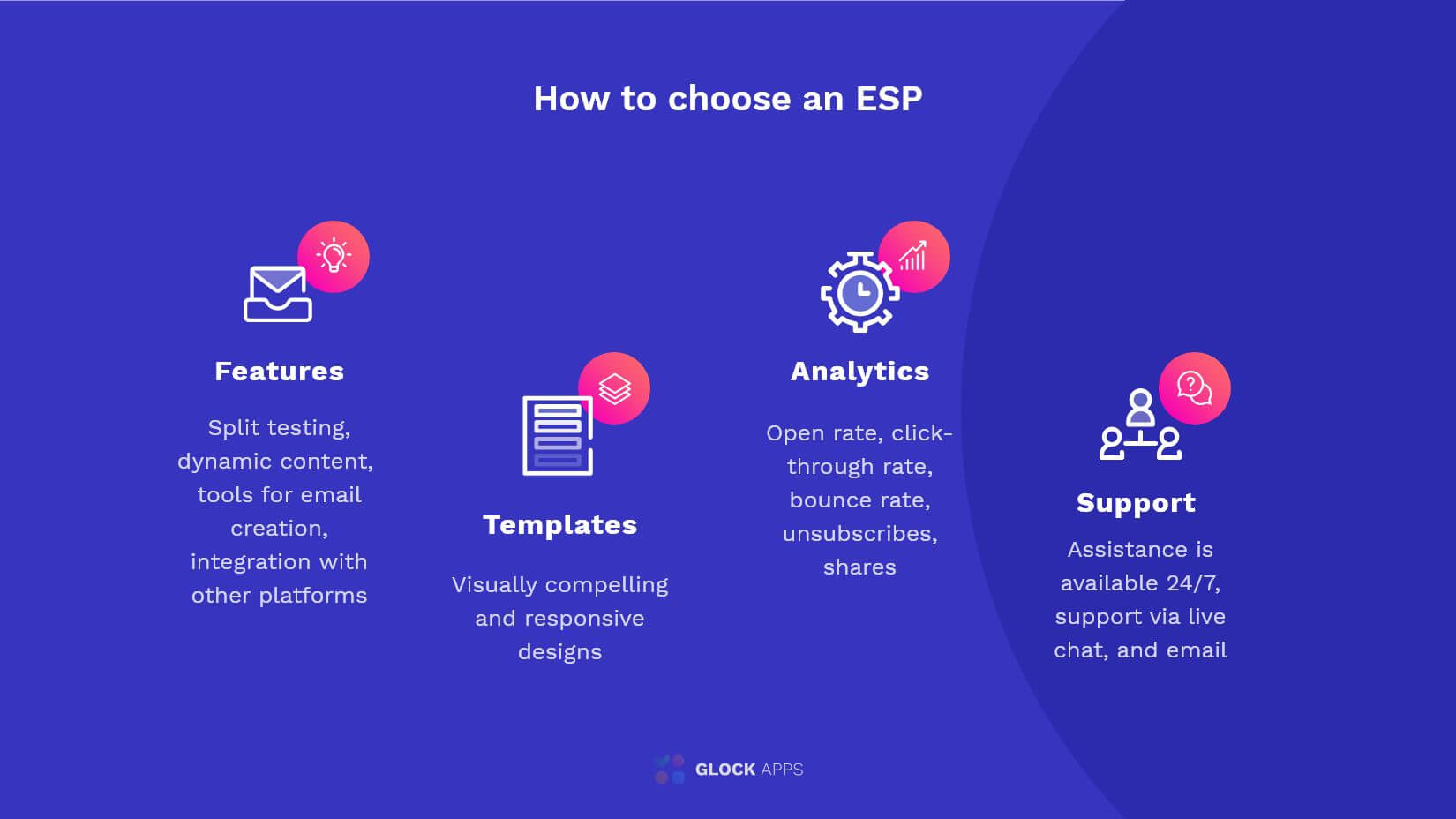ISPs and ESPs: What It Is and How to Choose

So many times, when talking to a client, I have been asked questions: ‘What is ISP? What is ESP? What is the difference? I understand how confusing these terms might seem at first, but with the insights from this article, you’ll know everything there is to know about ESPs and ISPs, how they work and how to choose the right ESP for your email marketing needs and preferences. Let’s go!
What is ISP?
ISP stands for Internet Service Provider. It is a company that gives you access to the Internet and charges you for doing so. Most commonly people refer to the ISP simply as ‘provider’ that’s why the term itself is unfamiliar to many. The largest ISPs in the US are AT&T, Verizon, Comcast, and others. Now that you know what is ISP, who’s yours?
Here’s where confusion strikes: some refer to mailbox providers as Inbox Service Providers, which also abbreviates as ISP. It is not commonly used, and not entirely correct to address these types of companies as ISPs. Internet Service Providers can give you a mailbox, but they are not the only ones providing this option.
What is a Mailbox Provider?
Mailbox Provider or a Mail Service Provider is a company that hosts email services. There are different types of email providers:

- ISPs: companies that provide you with access to the Internet can also give you a mailbox. The downside of having a mailbox of your ISP is that whenever you choose to change the Internet provider, you would have to save all the data from your emails because your mailbox will no longer be available, and the information will be lost.
- Free mailbox providers: the most common email providers nowadays. You might use their services yourself – among the largest are AOL, Yahoo!, Gmail, Outlook.
- Premium mailbox providers: they deliver paid mailbox services with a particular set of benefits. Free mailbox providers, such as Outlook, Yahoo and others also offer premium services with no advertising, backups and other features. Although not so common among people, premium mailbox providers have their clientele, mostly among businesses.
- Vanity mailbox providers: their email addresses are not established for communication, as we understand it. They receive and forward emails, becoming a transit hub of a sort, between the sender and the recipient. This type of mailboxes is called ‘vanity email’ because it has a person’s or business’s domain name in the address for a better brand awareness.
Nowadays, in email marketing, many refer to major mailbox providers like Gmail or AOL as ISPs, but technically it is incorrect. You cannot access your mailbox without access to the internet, which they do not provide. Now that we figured out ISPs and mailbox providers, let’s move on to the email marketing service providers.
What is ESP and Why Do You Need It?
ESP stands for Email Service Provider, also referred to as Email Marketing Service Provider. It is created specifically to fulfill email marketing needs that usual mailbox providers can’t sustain, allowing you to send email campaigns in bulk.
You may ask, why would I bother figuring out what is ESP and how does it work if I can send my marketing mail from a free Gmail account?
Unfortunately, many downsides will make your work simply impossible as your company grows. Free mailboxes are not designed to send large volumes of emails. For example, using Gmail you can only send emails to 500 recipients per 24 hours, so if you need to send tens or hundreds of thousands of letters at once, you won’t have other options but to switch to third-party tools.
Features provided may differ between ESPs, but here are undeniable benefits you get:
- sending large volumes of emails;
- segmenting email list according to your preferences;
- managing subscriptions and other email list-related tasks;
- creating visually appealing emails with ESP-provided tools;
- tracking campaign performance.
What is ESP is no longer a question. By now, you probably want to know how to choose one, and start your next email blast.
How to Choose an ESP
Email marketing service providers come in all shapes and sizes. To start your quest to find the best one for you, define your goals first. What is your email marketing strategy? What kind of emails are you planning to send, and how are you going to measure their performance? Knowing what type of content you will send out, and what kind of metrics you are planning to track, will define the features, valuable for you in an ESP.
Here is the list of top questions you have to answer when choosing an ESP:

-
Does it have all the features you need?
Split testing, dynamic content, tools for email creation, integration with other platforms – don’t skip any point of your list, make sure the ESP has it all.
-
Does it have mobile-friendly templates?
Nowadays, people open more emails on the phone than on a laptop. If you are planning to create your messages using ESPs services, make sure they have great designs and mobile-friendly templates, so that your email is displayed well across different mobile devices.
-
What analytics does it have?
Open rate, click-through rate, bounce rate, unsubscribes, and shares must be present on an ESP’s dashboard.
-
Will the company support you?
Whenever you encounter a problem or need help, the last thing you want is a long waiting for an answer from a support team. Make sure that assistance is available 24/7, check if live chat and email answers are prompt.
Also, take into account the usability and security level of the email marketing service provider.
When you tick all the boxes with your answers, finding a perfect ESP for your email marketing needs will be a piece of cake. A good ESP will increase your email deliverability and make your everyday work much easier.
Takeaways
ESPs and ISPs look confusing only at first sight, in reality, they are two absolutely different things.

What is ISP? It stands for Internet Service Provider – a company that gives you access to the Internet.
Sometimes people confuse Mailbox Providers with ISP because internet providers can also have a mailbox service. So, ISP could be a mailbox provider, but apart from it, there are free mailbox providers, like Gmail, AOL, Yahoo!; there are also premium email services and vanity emails.
Nowadays, many marketers expand the abbreviation ISP to any major mailbox provider, but technically, it is incorrect.
What is ESP? Email Service Provider – a company that provides mailing services for email marketers, allowing them to send out bulk emails. It has many different features that make email campaign sending easier and more efficient.
ESPs have undeniable benefits for email marketing: sending out large volumes of emails, mailing list management, and campaign performance analytics. Many ESPs provide tools for email template creation, split testing options, and integration options with other platforms.
To find an ESP that will work just for you, there is a set of questions to be answered. Most importantly, make sure you know the goals of your email marketing strategy, the metrics you need for tracking campaign success, and the features you are looking for in the ESP.



